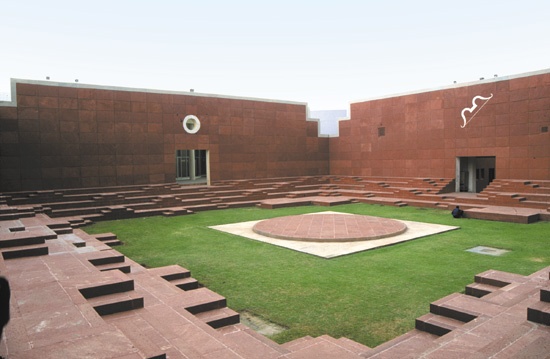Correa, Charles
Indian architect
in full Charles Mark Correa
born September 1, 1930, Secunderabad, India
Indian architect and urban planner known for adapting Modernist tenets to local climates and building styles. In the realm of urban planning, he is particularly noted for his sensitivity to the needs of the urban poor and for his use of traditional methods and materials.
Correa began his studies at Saint Xavier's College at the University of Bombay (now Mumbai), and he went on to study at the University of Michigan at Ann Arbor (1949–53) and the Massachusetts Institute of Technology (MIT) in Cambridge, Massachusetts (1953–55). In 1958 he established his own Bombay-based professional practice.
Correa's early work combined traditional architectural values—i.e., the colonial bungalow, traditional symmetrical space—with the Modernist use of materials exemplified by figures such as Le Corbusier (Corbusier, Le), Louis I. Kahn (Kahn, Louis I.), and Buckminster Fuller (Fuller, R Buckminster). In particular, Correa was influenced by Le Corbusier's use of striking concrete forms. The importance of the site was a constant in Correa's approach. Complementing the Indian landscape, he worked on an organic and topographic scale in early commissions such as his Gandhi Smarak Sangrahalaya (1958–63) in Ahmedabad and the Handloom Pavilion (1958) in Delhi. Considerations of the Indian climate also drove many of Correa's decisions. For residential commissions, he developed the “tube house,” a narrow house form designed to conserve energy. This form was realized in the Ramkrishna House (1962–64) and the Parekh House (1966–68), both in Ahmedabad, which has a hot and arid climate. Also in response to climate, Correa often employed a large oversailing shade roof or parasol, an element first seen in the Engineering Consultant India Limited complex (1965–68) in Hyderabad.
In the late 1960s, Correa began his career as an urban planner, creating New Bombay (now Navi Mumbai), an urban area that provided living and housing for many who lived across the harbour from the city limits. When designing in the midst of overpopulated cities, he tried to create quasi-rural housing environments, as is evident in his low-cost Belapur housing sector in New Bombay (1983–86). In all of his urban planning commissions, Correa avoided high-rise housing solutions, focusing instead on low-rise solutions that, in combination with common spaces and facilities, emphasized the human scale and created a sense of community.
 His later works, which continued his long-standing interests, include Surya Kund (1986) in Delhi; the Inter-University Centre for Astrology and Astrophysics (1988–92) in Pune, Maharashtra; and the Jawahar Kala Kendra arts complex (1986–92) in Jaipur, Rajasthan. From 1985 to 1988 he served as chairman of India's National Commission on Urbanisation, and from 1999 he served as a consulting architect to the government of Goa.
His later works, which continued his long-standing interests, include Surya Kund (1986) in Delhi; the Inter-University Centre for Astrology and Astrophysics (1988–92) in Pune, Maharashtra; and the Jawahar Kala Kendra arts complex (1986–92) in Jaipur, Rajasthan. From 1985 to 1988 he served as chairman of India's National Commission on Urbanisation, and from 1999 he served as a consulting architect to the government of Goa.Correa has taught in many universities, both in India and abroad, including MIT and Harvard University (both in Cambridge, Massachusetts) and the University of London. His many awards include the Royal Gold Medal for Architecture from the Royal Institute of British Architects; the Praemium Imperiale prize for architecture (1994), awarded by the Japan Art Association; and the Aga Khan Award for Architecture (1998).
Additional Reading
Hasan-Uddin Khan, Charles Correa: Architect in India, rev. ed. (1989).
- Toni Cade Bambara
- Tonight Show, The
- Toni Morrison
- Toni Stone
- Tonk
- Tonkawa
- Tonkin
- Tonkin, Gulf of
- Tonle Sap
- tonnage
- tonnage and poundage
- tonos
- tonsil
- tonsillitis
- Tonson, Jacob
- tonsure
- Tonto
- Tonto National Monument
- Tonty, Henri de
- Tony Benn
- Tony Bennett
- Tony Blair
- Tony Canzoneri
- Tony Garnier
- Tony Gwynn